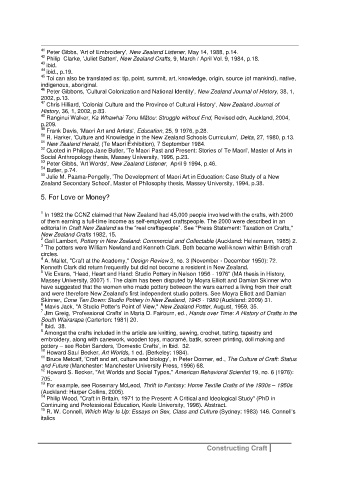Page 308 - Constructing Craft
P. 308
41 Peter Gibbs, 'Art of Embroidery', New Zealand Listener, May 14, 1988, p.14.
42
Philip Clarke, 'Juliet Batten', New Zealand Crafts, 9, March / April Vol. 9, 1984, p.18.
43 ibid.
44
ibid., p.19.
45
Toi can also be translated as: tip, point, summit, art, knowledge, origin, source (of mankind), native,
indigenous, aboriginal.
46
Peter Gibbons, 'Cultural Colonization and National Identity', New Zealand Journal of History, 38, 1,
2002, p.13.
47
Chris Hilliard, 'Colonial Culture and the Province of Cultural History', New Zealand Journal of
History, 36, 1, 2002, p.83.
48
Ranginui Walker, Ka Whawhai Tonu Mätou: Struggle without End, Revised edn, Auckland, 2004,
p.209.
49 Frank Davis, 'Maori Art and Artists', Education, 25, 9 1976, p.28.
50
R. Harker, 'Culture and Knowledge in the New Zealand Schools Curriculum', Delta, 27, 1980, p.13.
51 New Zealand Herald, (Te Maori Exhibition), 7 September 1984.
52
Quoted in Philippa Jane Butler, 'Te Maori Past and Present: Stories of Te Maori', Master of Arts in
Social Anthropology thesis, Massey University, 1996, p.23.
53
Peter Gibbs, 'Art Words', New Zealand Listener, April 9 1994, p.46.
54 Butler, p.74.
55
Julie M. Paama-Pengelly, 'The Development of Maori Art in Education: Case Study of a New
Zealand Secondary School', Master of Philosophy thesis, Massey University, 1994, p.38.
5. For Love or Money?
1
In 1982 the CCNZ claimed that New Zealand had 45,000 people involved with the crafts, with 2000
of them earning a full-time income as self-employed craftspeople. The 2000 were described in an
editorial in Craft New Zealand as the “real craftspeople”. See "Press Statement: Taxation on Crafts,"
New Zealand Crafts 1982, 15.
2
Gail Lambert, Pottery in New Zealand: Commercial and Collectable (Auckland: Heinemann, 1985) 2.
3
The potters were William Newland and Kenneth Clark. Both became well-known within British craft
circles.
4
A. Mallet, "Craft at the Academy," Design Review 3, no. 3 (November - December 1950): 72.
Kenneth Clark did return frequently but did not become a resident in New Zealand.
5
Vic Evans, "Head, Heart and Hand: Studio Pottery in Nelson 1956 - 1976" (MA thesis in History,
Massey University, 2007) 1. The claim has been disputed by Moyra Elliott and Damian Skinner who
have suggested that the women who made pottery between the wars earned a living from their craft
and were therefore New Zealand’s first independent studio potters. See Moyra Elliott and Damian
Skinner, Cone Ten Down: Studio Pottery in New Zealand, 1945 - 1980 (Auckland: 2009) 31.
6
Mavis Jack, "A Studio Potter's Point of View," New Zealand Potter, August, 1959, 35.
7
Jim Greig, ‘Professional Crafts’ in Maria D. Fairburn, ed., Hands over Time: A History of Crafts in the
South Wairarapa (Carterton: 1981) 20.
8 Ibid. 38.
9
Amongst the crafts included in the article are knitting, sewing, crochet, tatting, tapestry and
embroidery, along with canework, wooden toys, macramé, batik, screen printing, doll making and
pottery – see Robin Sanders, ‘Domestic Crafts’, in Ibid. 32.
10 Howard Saul Becker, Art Worlds, 1 ed. (Berkeley: 1984).
11
Bruce Metcalf, ‘Craft and art, culture and biology’, in Peter Dormer, ed., The Culture of Craft: Status
and Future (Manchester: Manchester University Press, 1996) 68.
12
Howard S. Becker, "Art Worlds and Social Types," American Behavioral Scientist 19, no. 6 (1976):
705.
13
For example, see Rosemary McLeod, Thrift to Fantasy: Home Textile Crafts of the 1930s – 1950s
(Auckland: Harper Collins, 2005).
14
Philip Wood, "Craft in Britain, 1971 to the Present: A Critical and Ideological Study" (PhD in
Continuing and Professional Education, Keele University, 1996). Abstract.
15
R. W. Connell, Which Way Is Up: Essays on Sex, Class and Culture (Sydney: 1983) 146. Connell's
italics
Constructing Craft

